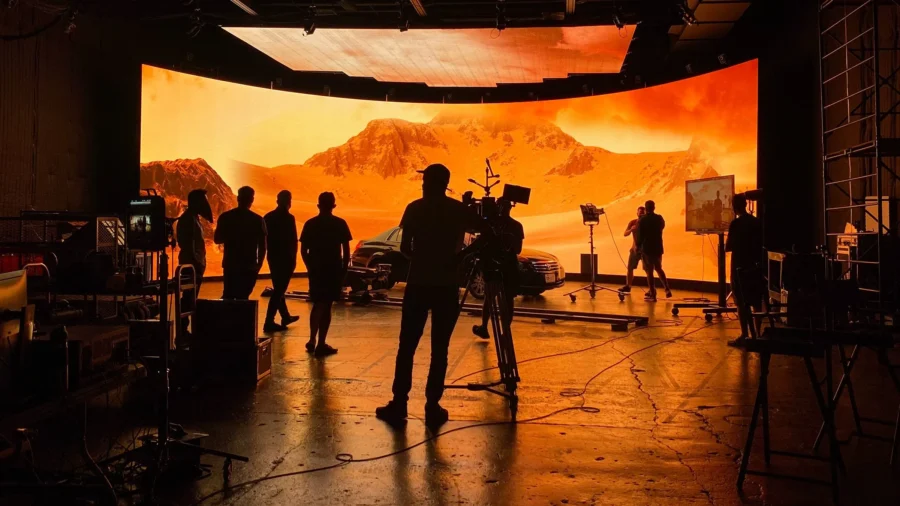Since its beginnings, cinema has been inextricably linked to technological innovation. From the hand-cranked Cinématographe of the Lumière brothers to today’s digital age, every breakthrough has brought aesthetic, political, and economic waves. When sound emerged in the 1920s, it was initially dismissed as a gimmick, but by 1929, talkies had taken over global cinemas. Some European filmmakers feared the dominance of dialogue would destroy the visual power of silent film. A similar revolution followed with color, which became standard only in the 1950s, offering directors a “hyperreal” spectrum for emotional storytelling. Politically, sound and color became new propaganda tools and markers of cultural identity. Economically, they required massive investment, cinemas had to adapt quickly to new projection technologies.
At the end of the 20th century, the digital revolution brought yet another transformation: CGI, Dolby sound systems, nonlinear editing, digital projectors. Each of these phases showed the industry’s ability to adapt, though not without resistance. Some directors clung to analog film well into the 2010s. Today, artificial intelligence (AI) presents the next transformation. Some argue that AI could eclipse all previous innovations in its impact, because unlike sound or color, AI reaches into nearly every part of the filmmaking process: from idea generation to screenwriting, visual effects, acting, voice work, and distribution. Fascination and unease grow in equal measure. Is AI a new creative tool, or a threat to jobs, copyright, and the soul of cinema?

History of the Film Industry: Lessons from Technological Turning Points
Film history shows that technological shifts are always double-edged. When talkies replaced silent film, many careers ended overnight. New genres like musicals flourished. Color, too, was initially dismissed before becoming an expressive standard. While not everyone embraced it immediately, some like Chaplin or Hitchcock stayed with black and white, color eventually broadened cinematic language.
Later, digital tools transformed production and distribution: editing tables gave way to software; film reels to digital masters; theaters to streaming platforms. Early skepticism gave way to practicality and new aesthetics, think of CGI dinosaurs in Jurassic Park or the rotating bullet time in The Matrix. These revolutions forced the industry to reinvent itself but also produced creative booms.
AI is different. For the first time, a technology doesn’t just enhance tools, it participates in content creation. While previous changes affected individual production stages, AI cuts across all of them. Some hope it will expand creative possibilities as earlier innovations did. Others warn that AI could fundamentally alter creative labor and authorship. The film industry has always reinvented itself, but this time, its most essential creative processes are being rewritten.
Studies and Data: Where AI Is Already Being Used
Current estimates suggest that tens of thousands of jobs in the U.S. entertainment sector may be disrupted in the next few years, particularly in 3D modeling, animation, voice generation, compositing, and screenwriting. Across the U.S., over 200,000 roles could be impacted by 2026.
Technical roles behind the scenes are most vulnerable: 3D design, environment modeling, voice cloning, sound design, software development, storyboarding, animation, and concept art. Managers are less concerned about actors and writers, partly because recent labor agreements offer some protection for those professions.
Global institutions also sound the alarm: UNESCO warns that hundreds of thousands of jobs in creative industries, background performers, translators, illustrators, could be threatened. However, it also emphasizes that blanket pessimism is misguided. Regulation is needed to mitigate harm (like AI trained on stolen data), but there are also undeniable opportunities.
While the media buzzes with speculation, Hollywood has mostly used AI in experimental ways. Despite fears, nearly all TV and film scripts remain human-written. But AI is used more frequently behind the scenes: tools like Runway, Stable Diffusion, and Sora have been tested for visual prototyping, deepfake effects, and synthetic media. Synthesia, for example, claims to cut dubbing costs by 90%, generating speech and matching lip movement in dozens of languages. AI is no longer on the horizon, it’s here.

At-Risk Areas of the Film Industry
Despite optimism, AI poses real risks to jobs across filmmaking departments:
– Preproduction (Script and Storyboarding): AI tools can now spit out treatments and plot outlines in seconds. Text-to-image tools generate concept art or shot sequences. Where artists once spent days sketching, directors can now describe their vision to a machine and receive instant visuals.
– Visual Effects and Animation: AI is changing how blockbusters are built. From 3D modeling to motion tracking and rotoscoping, many tasks are being automated. Deepfakes can replace or de-age actors at a fraction of traditional VFX costs. One person with AI can now produce effects once requiring entire teams.
– Voice Acting and Dubbing: Voice cloning is a game-changer. Actors’ voices can be synthesized into multiple languages or used posthumously. Tools can recreate lip movements to match new dialogue. This challenges not just job security, but authenticity and consent.
– Editing and Postproduction: AI-assisted tools already sort footage, detect continuity errors, sync audio, and apply effects. Color correction and audio mixing are increasingly automated. Music scoring is also being transformed, AI can now compose convincing background tracks, raising concerns for composers.
Unions have responded. The Writers Guild and SAG-AFTRA struck to secure clauses around AI: studios must disclose AI use, writers can’t be replaced by generative text, and actors must consent to digital doubles. These wins matter, but protections vary across countries and non-union work remains unregulated.
Areas of Growth: AI’s Creative Upside
AI is not just eliminating jobs, it’s creating new opportunities:
– New Tools: AI editing software, virtual set design, automated translation, and intelligent scene analysis promise massive efficiency gains. Tools can now generate location designs, adjust weather, or recreate historical settings, all from text prompts.
– Indie and DIY Production: Indie filmmakers are using open-source tools to create short films with near-professional polish. Fan projects and TikTok creators are experimenting with AI characters and effects. The cost barrier to filmmaking is shrinking.
– New Professions: “Prompt engineers” are emerging as key roles, those who craft the perfect inputs to coax desired outputs from AI models. Studios are hiring AI supervisors, data ethicists, and creative technologists. A new class of professionals is taking shape.
– New Content and Formats: Interactive stories, algorithmic cinema, and AI-generated web series are gaining traction. AI Film Festivals are beginning to reward hybrid human-machine collaborations. A wave of micro-films, VR experiences, and AI-enhanced narratives may soon follow.
AI can democratize film production. With the right guidance, creators from underrepresented communities can use AI to tell stories in their own languages and styles. This, however, requires access and education, not just tools.

Acting and Performance: Adapting to the Digital Era
Actors are seeing their profession evolve rapidly:
– New Skills Required: Motion capture, voice licensing, and digital staging are now standard. Knowing how to act alongside CGI characters or respond to machine-generated dialogue is becoming essential.
– Digital Doubles and Consent: Studios must now ask permission before scanning actors’ faces or bodies. Contracts cover how and where AI replicas can be used. Background actors are demanding protections against being digitally cloned indefinitely.
– Brand and Image Control: Performers must think of themselves as brands, licensing their likenesses or protecting their image from misuse. Actors may appear in multiple projects at once, thanks to AI-powered replicas. But who owns the rights?
– Opportunities: AI might allow aging actors to reprise iconic roles without physical strain. Performers can expand their reach with minimal travel. Some artists are already earning passive income by licensing their voice or face to AI training programs.
Despite fears, the unique qualities of human performance remain irreplaceable. Audiences still crave real emotion, spontaneity, and presence. AI may multiply, but it cannot invent humanity.
Future Scenarios: What Will Filmmaking Look Like in 15 Years?
A few possibilities:
– Small Teams, Big Output: Three-person teams may produce feature-quality content using AI for location, lighting, and post. Studios could shrink while output increases.
– Interactive and Personalized Stories: Viewers may shape narratives in real time, choosing outcomes, characters, or themes. Films become experiences rather than fixed texts.
– New Genres and Markets: VR cinema, real-time generated stories, and infinite content loops are being explored. Whole new storytelling languages may arise.
– Cultural Concerns: There’s a risk that AI, trained on mainstream data, will flatten narrative diversity. Regional voices, languages, and styles may be marginalized. Biases in training data could replicate stereotypes.
Regulation, education, and inclusive development are key. Without them, AI could centralize power rather than democratize it.

Opportunities and Outlook: A Tool, Not a Threat
At its best, AI can support creativity. Writers use it to overcome blocks. Editors streamline workflows. Low-budget filmmakers achieve ambitious visions. The key is curation: selecting and shaping AI outputs with human taste, emotion, and cultural awareness.
Curatorial thinking, what to keep, discard, or refine, becomes the artist’s core job. AI can offer 1,000 options, but it cannot tell a good story. Ethics matter. The industry must set guidelines for consent, authorship, and attribution. Filmmakers should understand how AI works and where it can go wrong. Training, transparency, and responsibility are essential. AI, like photography or digital editing before it, can open new creative frontiers. But the heart of cinema, emotion, narrative, and human connection, must remain intact.
The Responsibility of an Evolving Artform
Cinema stands at a crossroads. AI is powerful and transformative, but it must be shaped with care. The industry must set boundaries, offer education, and uphold fairness. Used wisely, AI can become a partner, amplifying imagination, not replacing it. Audiences will still want stories told by humans, for humans. And storytellers, empowered by new tools, can ensure that the future of film is more diverse, expressive, and inclusive than ever before. Cinema’s soul doesn’t lie in the tools it uses, but in the truths it dares to tell.









